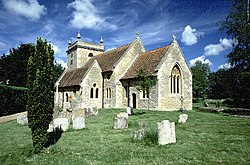Stadhampton
| Stadhampton | |
| Oxfordshire | |
|---|---|
 St John the Baptist, Stadhampton | |
| Location | |
| Grid reference: | SU603986 |
| Location: | 51°41’1"N, 1°7’43"W |
| Data | |
| Population: | 832 (2011, parish) |
| Post town: | Oxford |
| Postcode: | OX44 |
| Dialling code: | 01865 |
| Local Government | |
| Council: | South Oxfordshire |
| Parliamentary constituency: |
Henley |
| Website: | stadhampton.org |
Stadhampton is a village in Oxfordshire about seven miles south-east of Oxford. Stadhampton is close to the River Thame, a tributary of the River Thames. The village was first mentioned by name in 1146, and was in the ownership of the Bishops of Lincoln, the crown, and various Oxford colleges for most of subsequent history.[1] The village includes several buildings of historical and architectural interest, including a parish church with features dating back to the 12th-century.
Contents
Name
The name "Stadhampton" was recorded as Stodeham in 1146 and Stodham in 1316. The name is derived from Old English, probably Stod-hāmm meaning "river meadow where horses were kept".[2] Stadham has also been used, including colloquially to the present day, and the "ton" suffix seems to have been added relatively late in the village's history.[3]
History
The Domesday Book of 1086 does not mention Stadhampton by name, but the settlement evidently formed part of the demesne lands of the Bishop of Lincoln's Dorchester manor.[2] Dorchester on Thames was the first Anglo-Saxon bishopric of England, and was the de facto capital of Wessex until being displaced by Winchester in 660. Dorchester manor and the village of Stadhampton remained in the ownership of the Bishops of Lincoln for almost a thousand years until they passed into the ownership of Edward VI in 1547, continuing in the ownership of the crown until Elizabeth I granted the manor to Henry, Lord Norreys of Rycote. The village then passed through the ownership of several prominent families until being acquired by the Oxford colleges of Oriel and Christ Church in 1740, and subsequently by Magdalen College in 1927.[2]
On the main street is a 17th-century bakehouse, thatched and built of coursed stone and bearing the date 1658, that was used as a bakery until about 1914.[3]
In the 18th century Stadhampton had two clockmakers: James Jordan (born about 1751) and Thomas Jordan, who worked together.[4] Thomas repaired the turret clock at St Peter's parish church, Great Haseley on several occasions between 1770 and 1790.[4][5]
Outside links
| ("Wikimedia Commons" has material about Stadhampton) |
References
- ↑ "Towns and Villages Around Oxford | Stadhampton & Chiselhampton". http://www.visitoruk.com/Oxford/stadhampton-and-chiselhampton-C592-V16130.html.
- ↑ 2.0 2.1 2.2 Ekwall 1960, Stadhampton
- ↑ 3.0 3.1 Lobel 1962, pp. 81–92.
- ↑ 4.0 4.1 Beeson 1989, p. 116.
- ↑ Beeson 1989, p. 40.
- Beeson, CFC (1989). Simcock, AV. ed. Clockmaking in Oxfordshire 1400–1850 (3rd ed.). Oxford: Museum of the History of Science, Oxford. p. 116 0. ISBN 0-903364-06-9.
- Ekwall, Eilert, The Concise Oxford Dictionary of English Place-Names. Oxford, Oxford University Press, 4th edition, 1960. ISBN 0198691033
- A History of the County of Oxford - Volume 7 pp 81-92: Parishes: Stadhampton (Victoria County History)
- Nikolaus Pevsner: The Buildings of England: Oxfordshire, 1974 Penguin Books ISBN 978-0-300-09639-2
